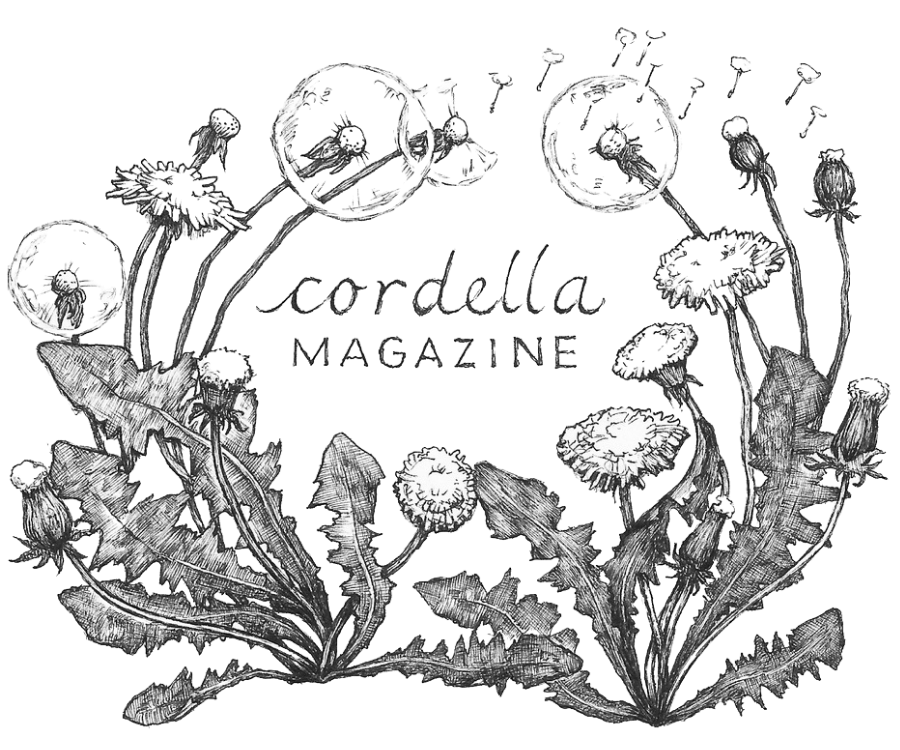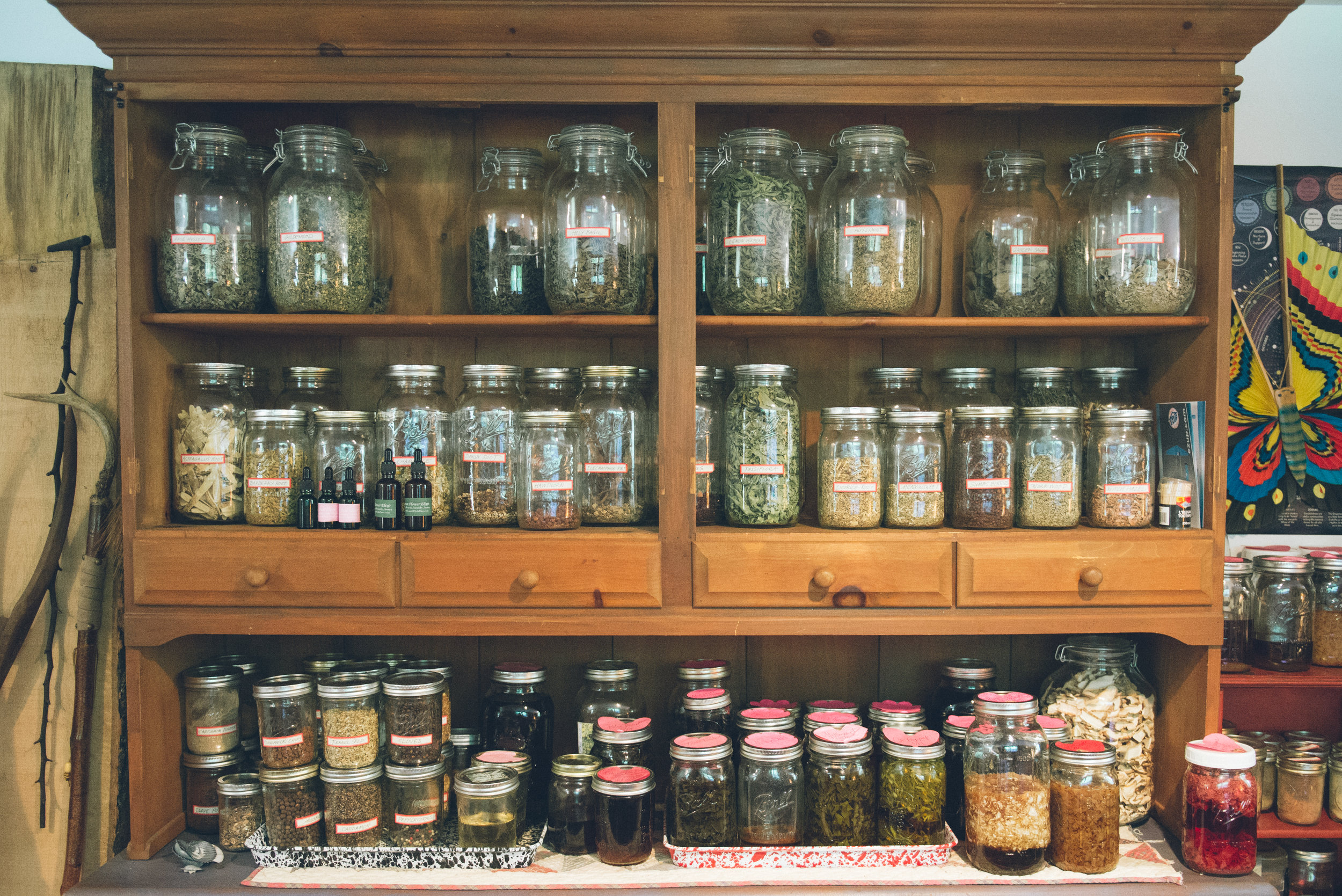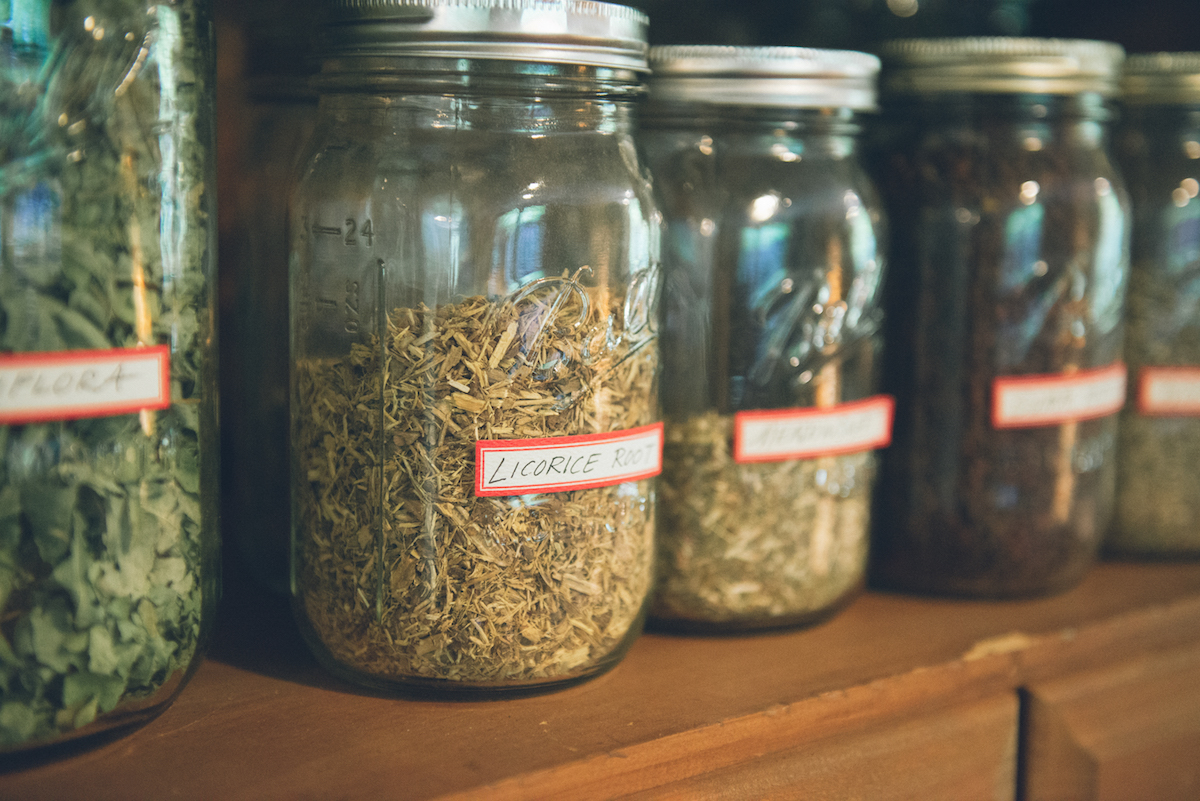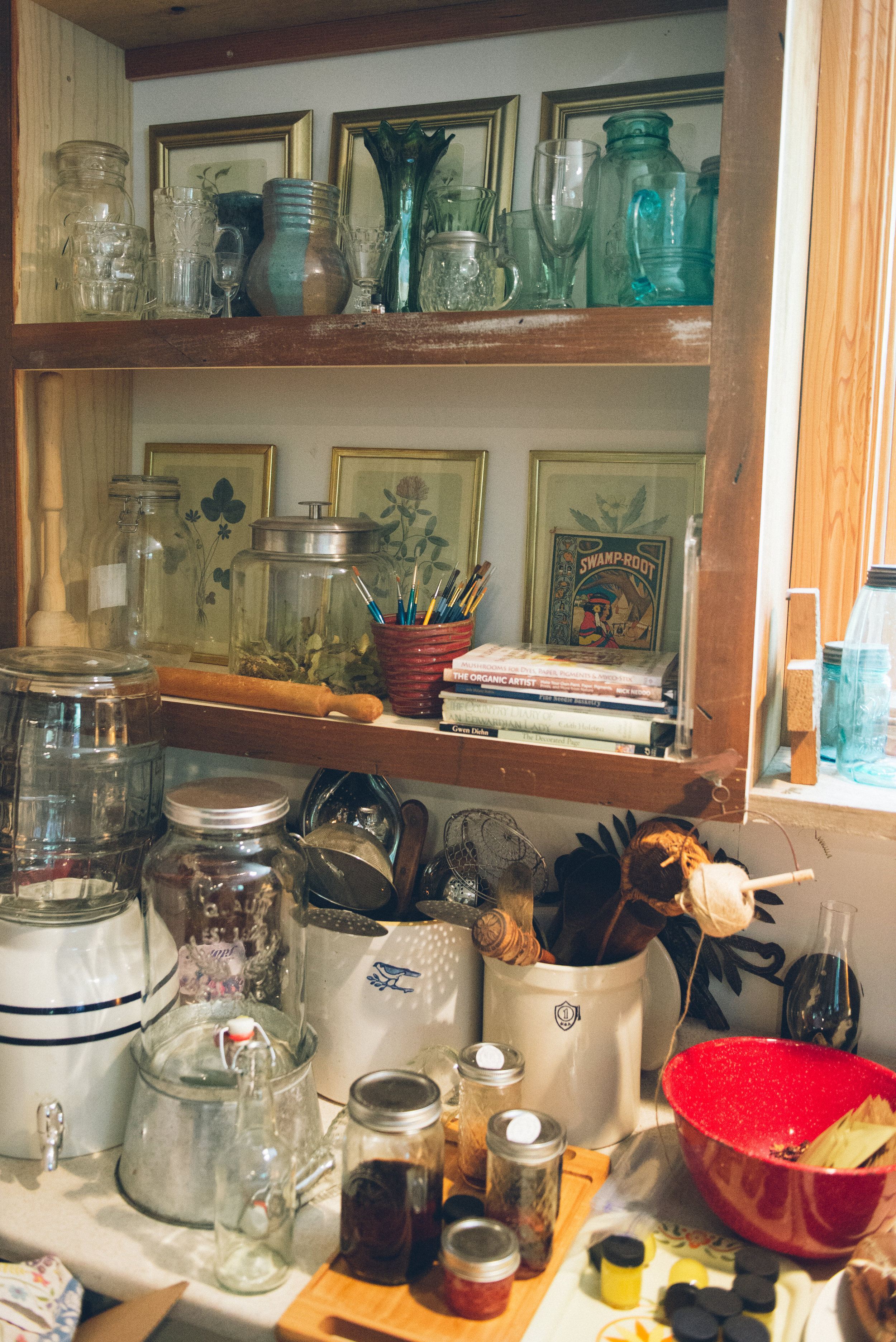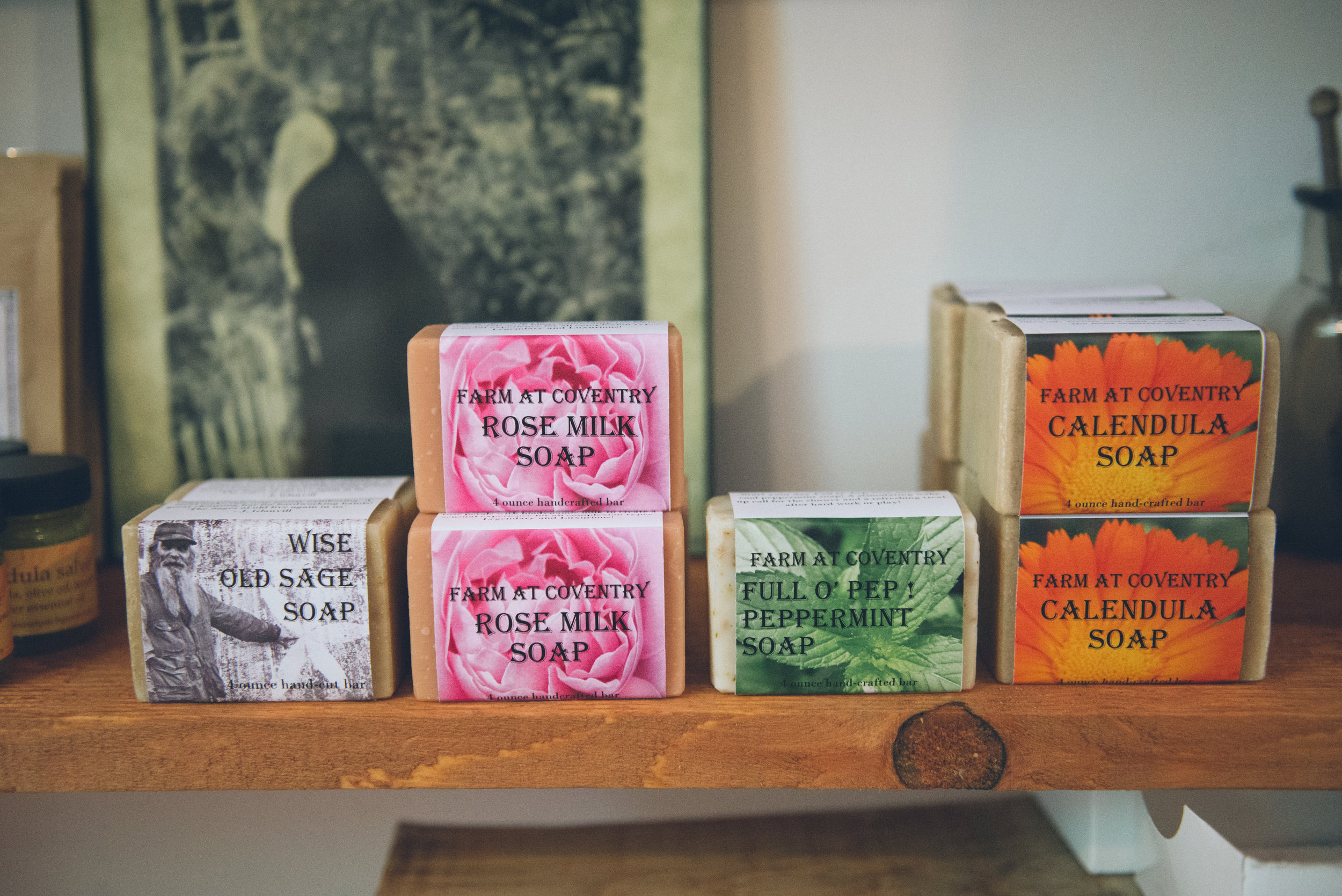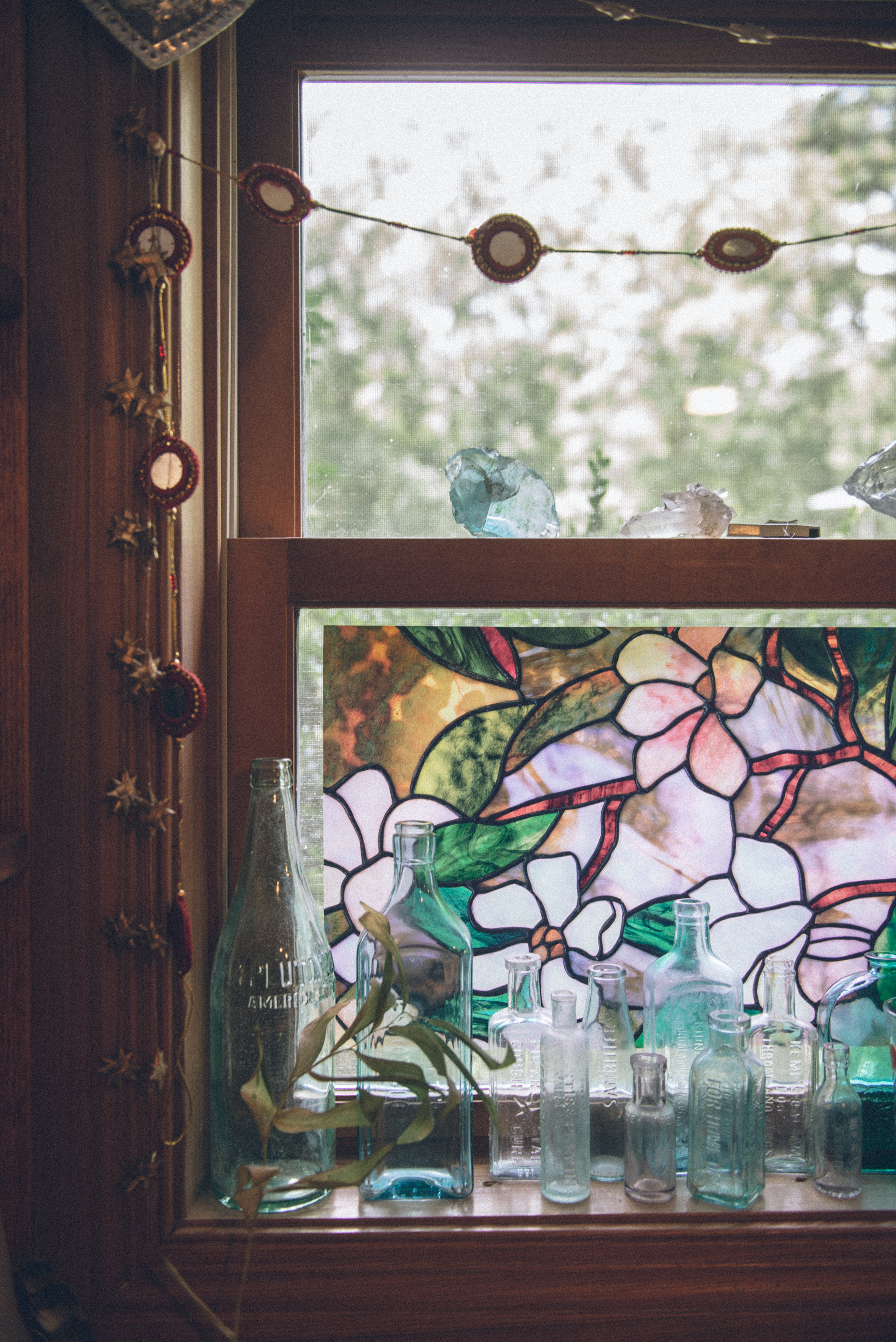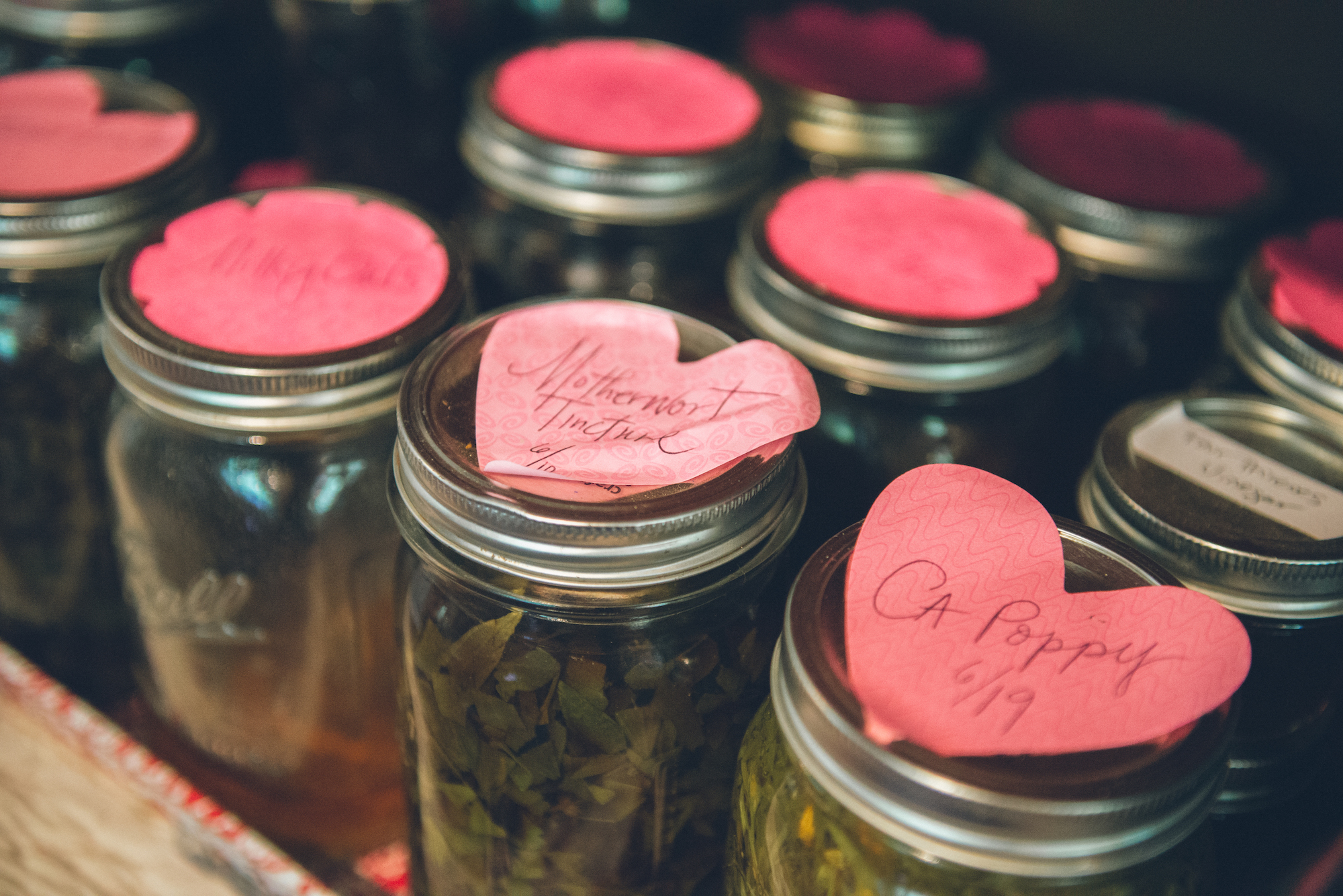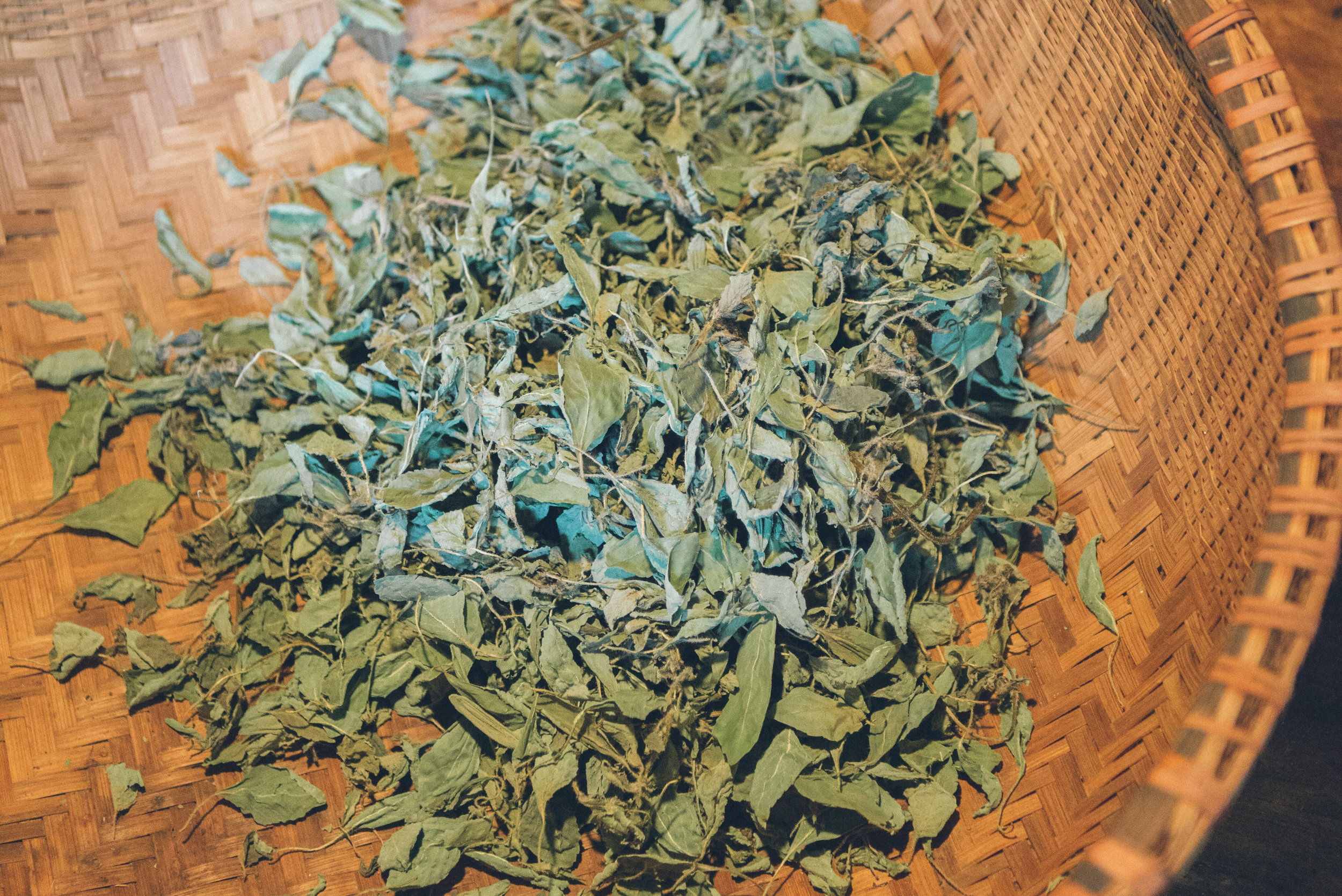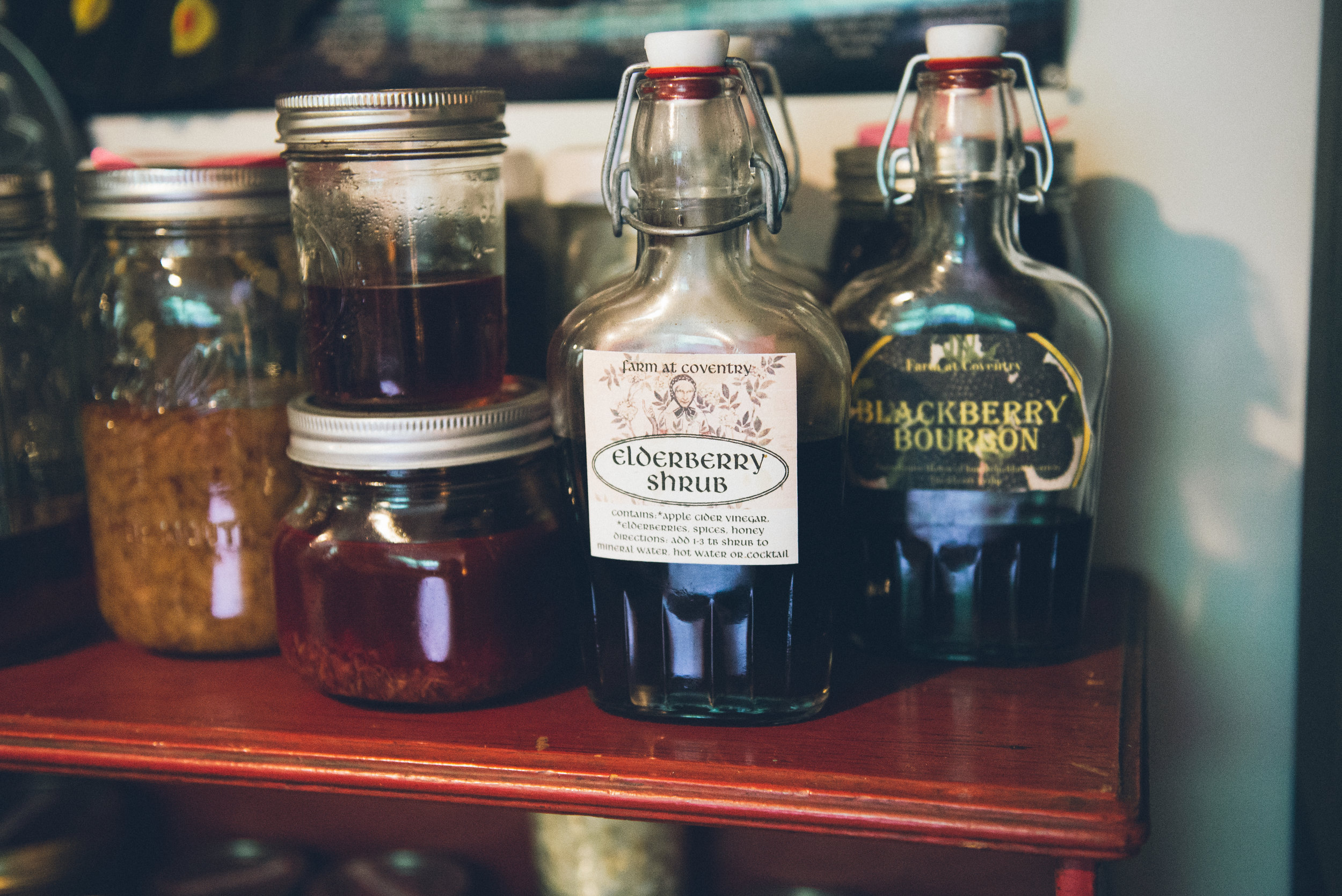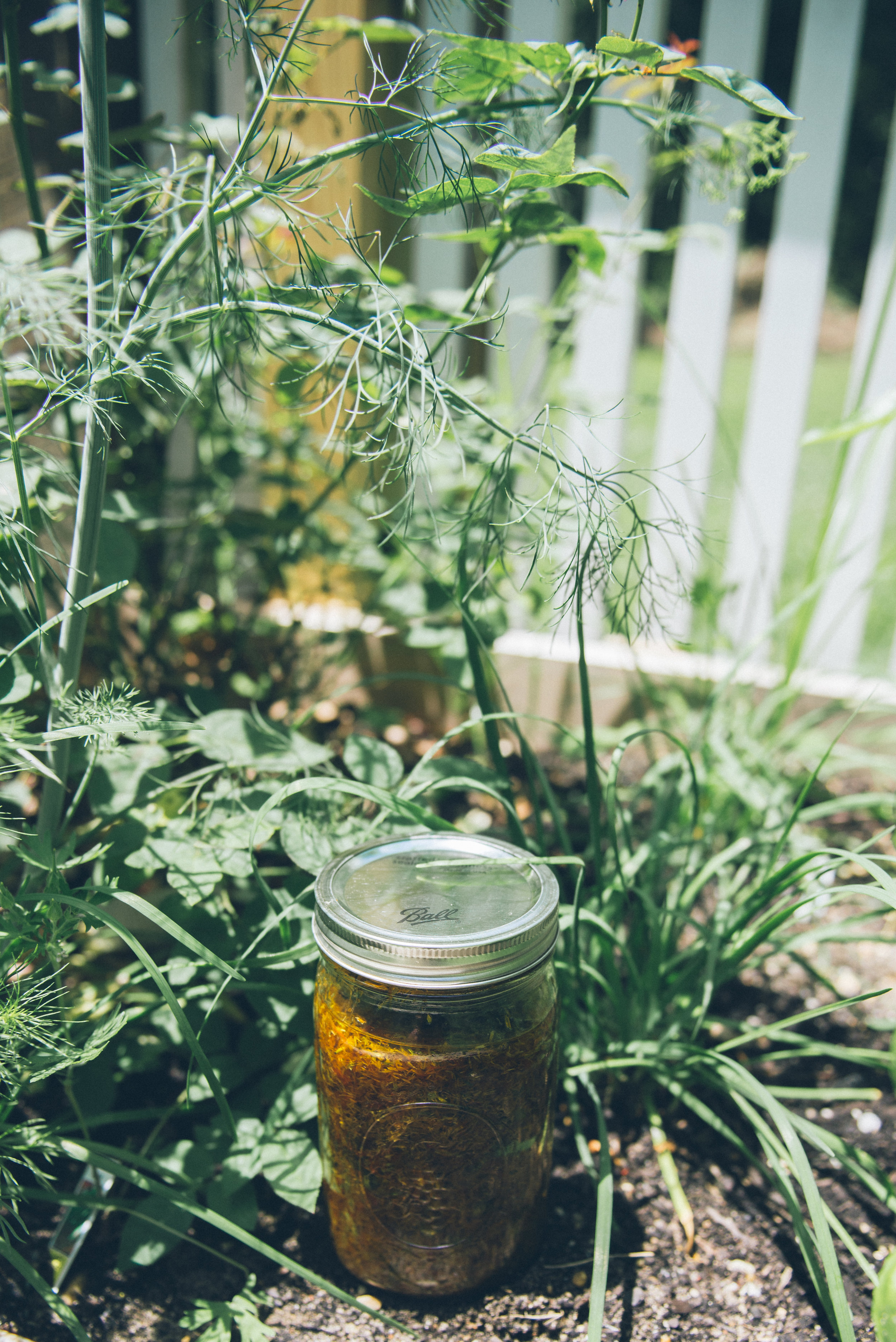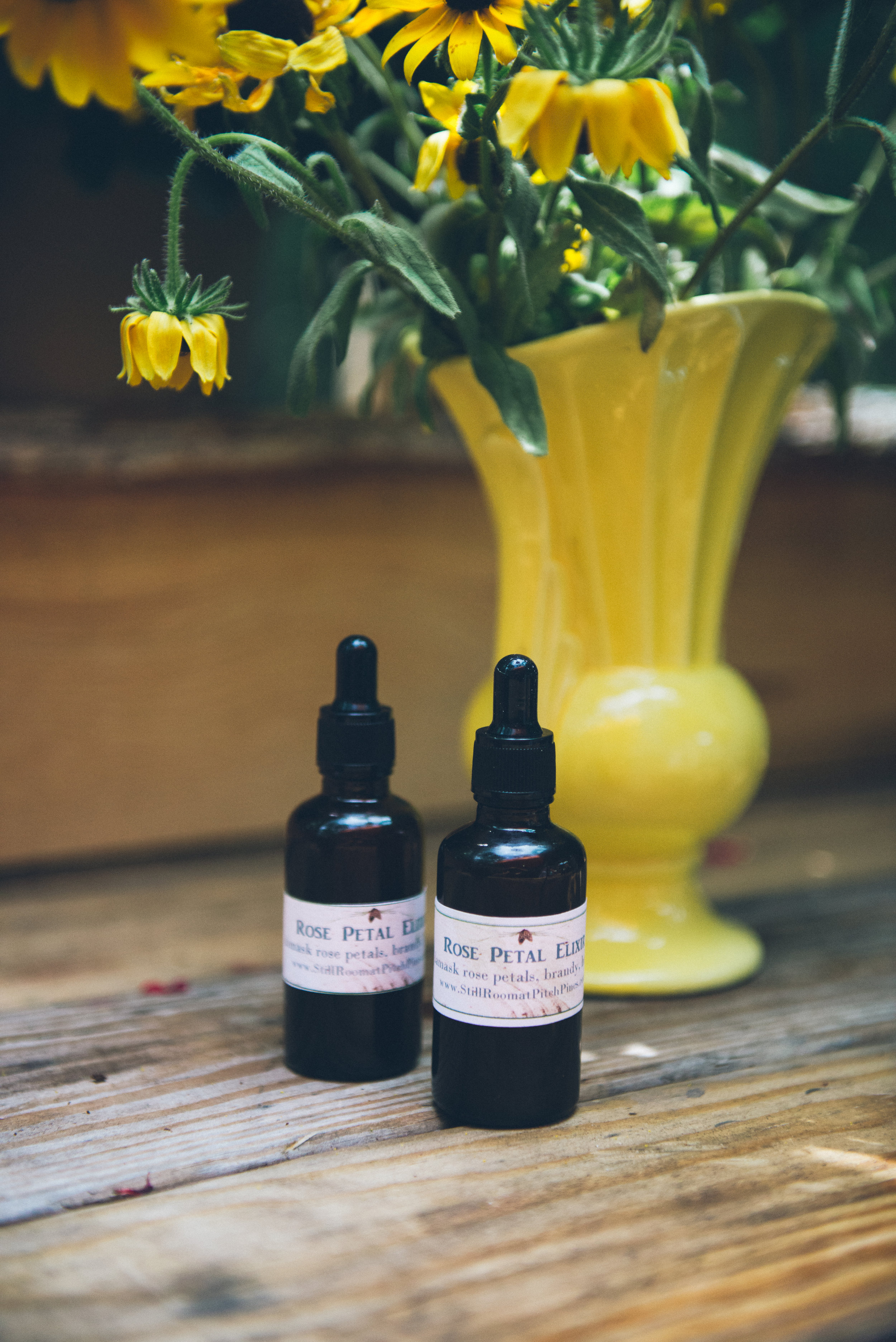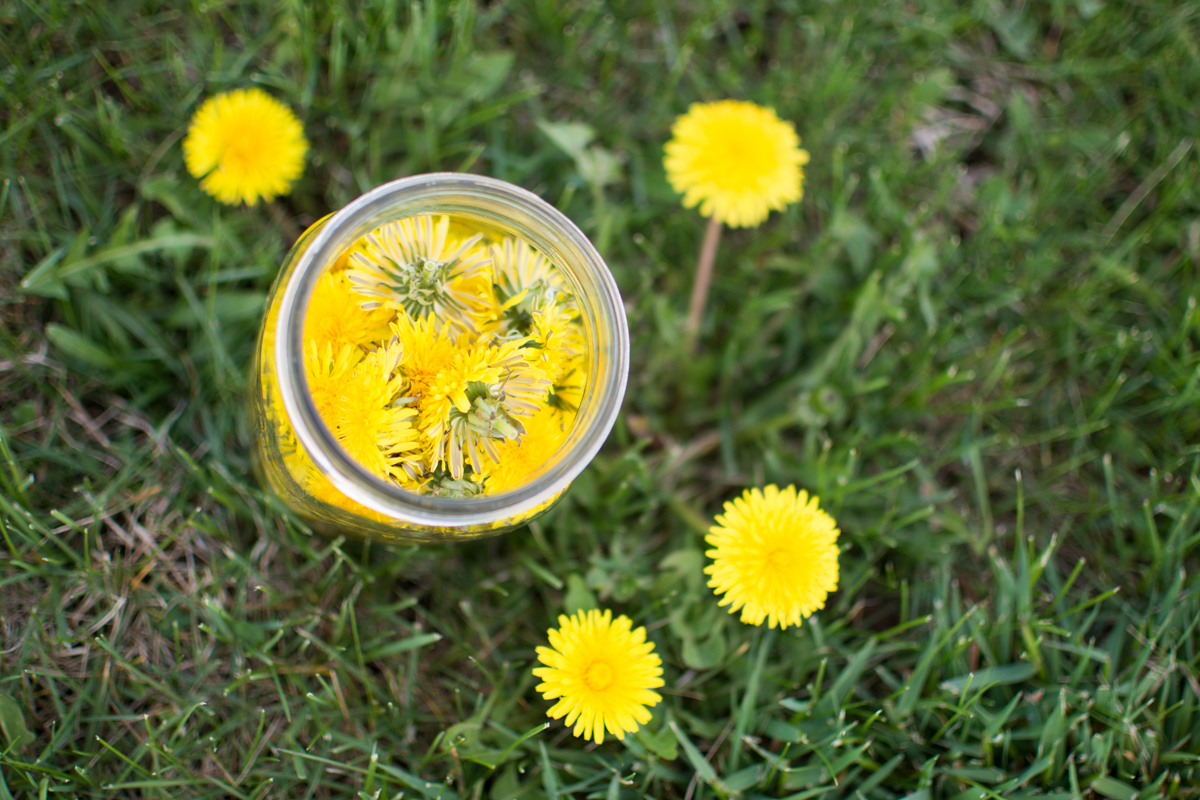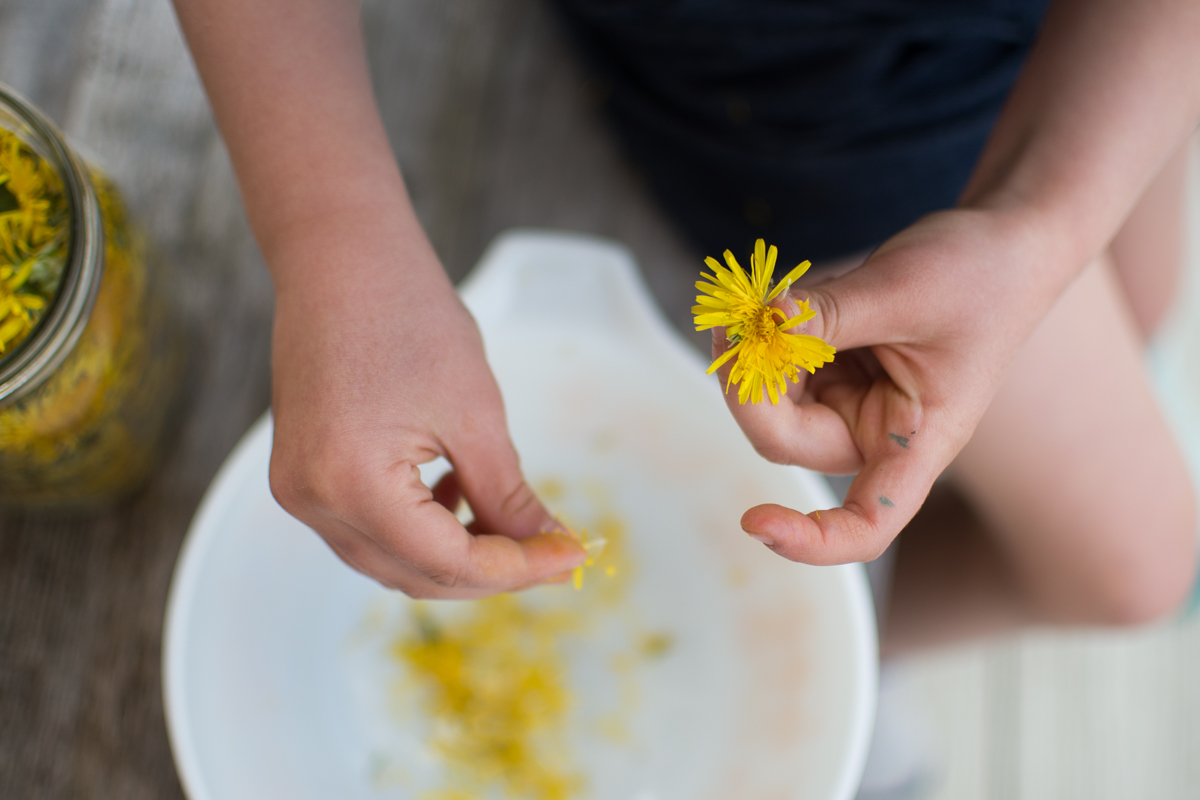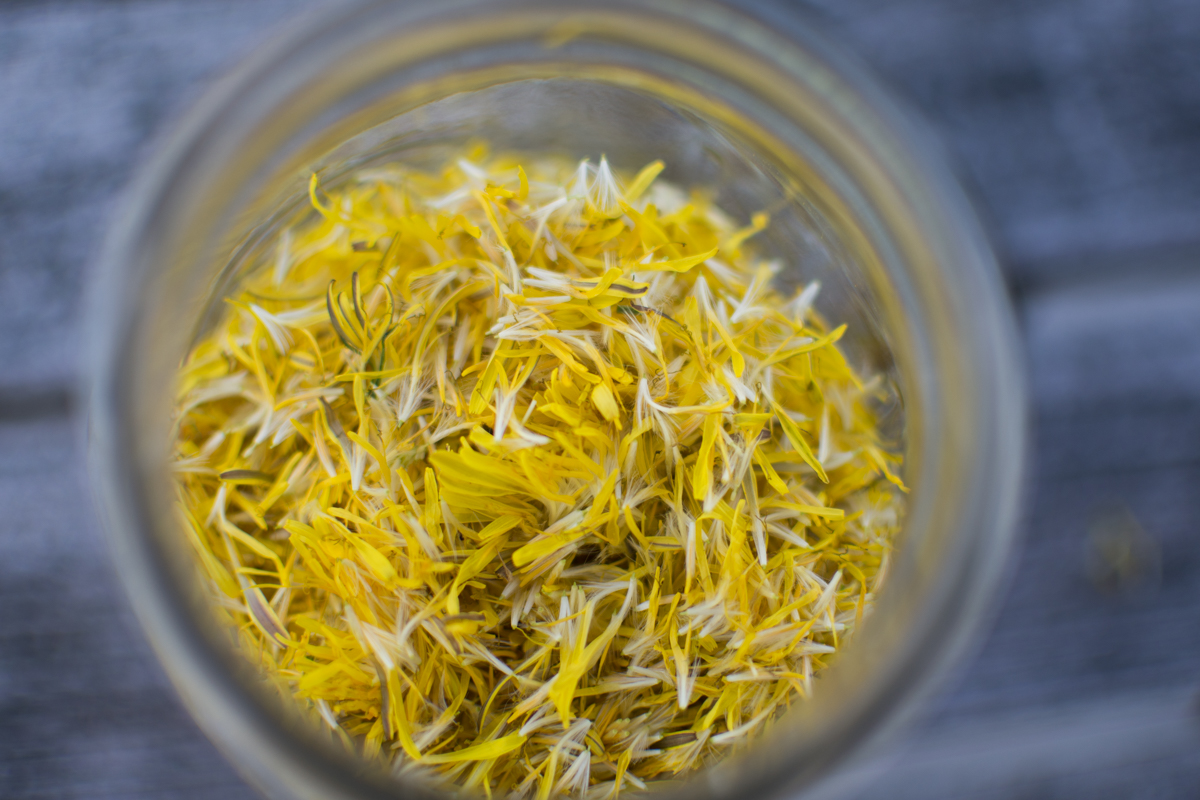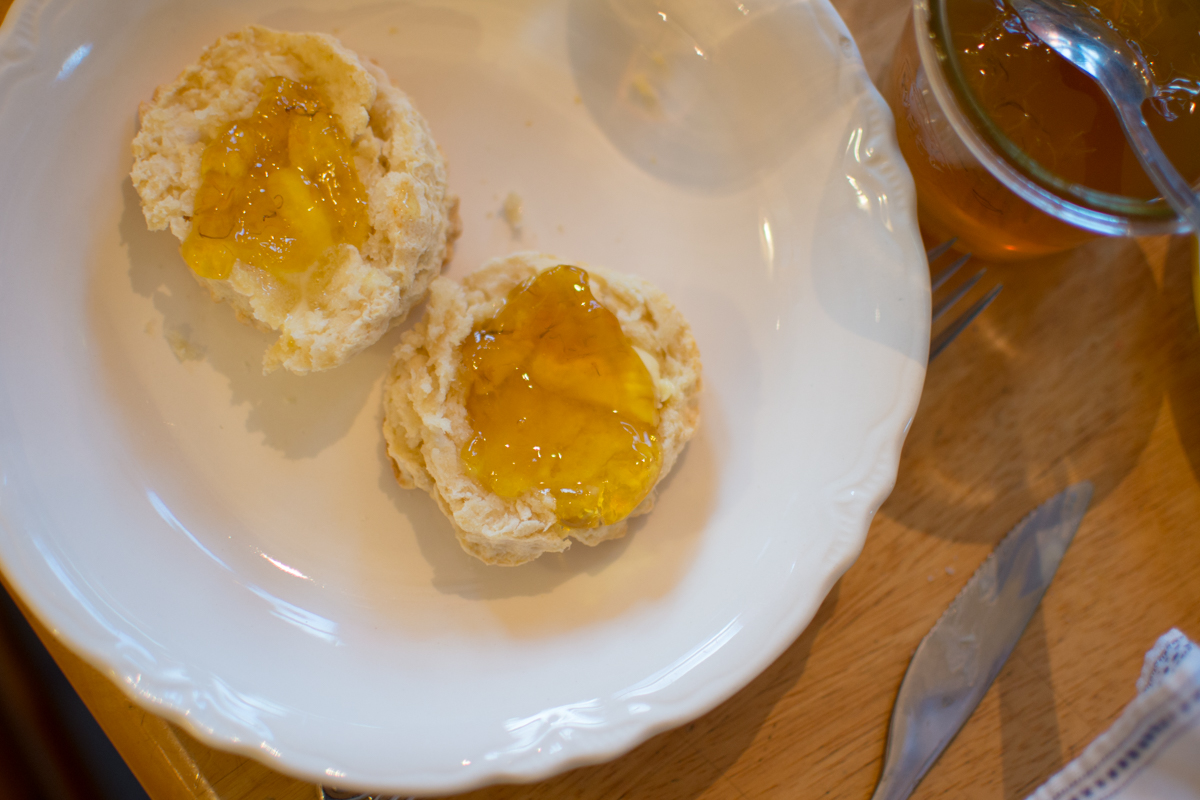Still Room at Pitch Pines
an interview with herbalist Susan Hess
photography by Cate Clother
I first met the work of Susan Hess in 2006, when I moved to Pennsylvania and began using her beautiful herbal products. I wanted to take her Homestead Herbalism course, but as a young mother with a very hectic schedule I wasn’t able to find the time, and remained secretly star-struck over this mythological person behind the products which had so blessed my life. It wasn’t until many years later when I realized I had actually met Susan in person, and was in fact friends with her daughter, Emily! Over coffee one morning with Emily my mouth dropped open as I made the connection… wait, your mother is THE Susan Hess? Emily laughed it off, “Yeah, I get that all the time. My mom is a local celebrity!” Since then Susan has also become a friend of mine, and even though we live on opposite coasts now I still glean so much from her herbal wisdom and warm, healing smile. I enjoyed spending the day with Susan and photographing her Homestead Herbalism class, and I hope that you, dear reader, find nourishment in these words and pictures (and in the delicious recipe at the end)!
Cate Clother: What first drew you to this work? Can you tell us about your path into herbalism?
Susan Hess: My interest in the healing profession began at a young age. My mother and grandmother were both registered nurses and it fascinated me that they would go to work to care for other people every day. I believe it was an unspoken hope that I would follow them on that same path. But in high school I was drawn to the creative arts and felt my artistic talents needed to be explored in that direction instead.
In 1981, I moved into an area of southeast PA that was surrounded by a hub of organic farms, an independently owned health food store, Waldorf education and alternative health care practitioners. My new next door neighbor told beautiful stories of delivering babies at home, grew a lush garden and sold fresh herbs to supplement the family income. This idyllic community and my dear neighbor had an enormous influence on my trajectory towards a more creative and holistic way of living.
When my own babies came along I often called my mother for advice, but felt pretty helpless when it came to providing my children comfort measures when they were sick. So off to the doctor we went for every little sniffle. Once when my youngest had a particularly stubborn bout with pneumonia, he was finishing up his second round of antibiotics and still coughing. The doctor mentioned that he may need to be hospitalized if the pneumonia didn’t turn the corner soon. I was terrified. When I asked what I might do for him in addition to the medication, he offered to send a visiting nurse to the house to instruct me on how to apply a mustard plaster. I was skeptical but hopeful!
That visit from a kind and compassionate nurse gave me a few home-care skills to supplement the antibiotics. In addition, she suggested adding extra garlic to the soup I had on the stove and instructed me on a steam inhalation treatment for the cough that included chamomile flowers and eucalyptus oil. When she left, my son and I both felt nurtured and cared for. I felt empowered to help my child and he healed rapidly in the days that followed. I was so inspired by that particular moment and those women that I wanted to dedicate my life to providing the same support for other women.
Cate: Herbalism is traditionally passed down from person to person. Who were your teachers and mentors along the way?
Susan: In addition to the women that I mentioned, I decided that if I were to be helpful to others I needed to have a proper education. In 1993, I worked in our local health food store and while I was able to help our customers to some degree, the owners offered to pay my tuition to the Herbal Therapeutics School of Botanical Medicine in Washington, NJ (now called David Winston’s Center for Herbal Studies). This three-year course of study with David Winston required an enormous commitment at that time in my life. I was a single mom, working full time and attending this program two hours away from home. But it was food for my soul and one of the best things I have ever stretched myself to do. I cannot stress the importance of learning one-on-one with a teacher. Building on individualized case studies and healing stories has a way of teaching that researching online can never compare to. There’s a huge difference between approaching herbalism as an art rather than memorizing a list of herbs used for specific ailments. In addition to David Winston, I learned so much from studying with Phyllis Light, Matthew Wood, Jennifer Tucker and of course, the healing plants themselves.
Cate: You are a teacher and a mentor now to many others. What has this experience been like for you?
Susan: When I finished my education, I was immediately asked to teach a class. It was never my intention to teach. I mostly wanted to help those looking to choose the right remedy from a daunting wall of supplements. But I reluctantly accepted the teaching offer and it just expanded organically from there.
The more experience and confidence I gained using the herbs that I grew and wildcrafted, the easier teaching became. The more ways I learned to preserve the herbs that grew around me, the more ways I was able to share those tastes and substances with others. I no longer had to study up before teaching, it just tumbled out naturally from my own experiences and stories. I found that people would relay those stories back to me years later as something “they never forgot.” I enjoy sharing that delight with others and seeing it register on their faces, hearing them share it with their children or friends. I learn best by storytelling, and using my senses of taste and smell. There is so much visceral information that goes beyond the intellect. When I share the same way that I learn, it ignites other avenues of learning besides reading words on a page. Teaching others to explore and play with herbs has really been one of my greatest pleasures. To see them empowered by that knowledge is rewarding.
Cate: Tell us a bit about your favorite herbs to grow and work with, and why?
Susan: Oh gosh, an herbalist’s least favorite question!! I think I can say with certainty that rose petals are a favorite of mine. At one time I had upwards of thirty damask rose bushes. When they bloomed on a sunny day in May, the fragrance was indescribable. I always say that carrying baskets full of fragrant rose petals makes me feel like a wealthy woman. They calm a frazzled nervous system but mostly they help to ease the heartache of grief, loss and longing.
Calendula is also right up there at the top of the list. First, it is incredibly easy and willing to grow from seed. It is one of the very first herbs I learned about as a vulnerary—or amazing skin healing herb. I began to use it for all manner of skin and mucosal inflammation. Then I took a summer to explore its benefits for gastrointestinal inflammation. Another summer I experimented using calendula petals as an edible flower. SO many layers to this resinous healing flower. Season after season of learning new things about a single plant. Building a long slow relationship with a plant, season after season, is a beautiful thing. The plants are never static. They are always teaching if we take the time to slow down and listen.
Cate: Along with growing your own herbs, you also practice wildcrafting. What do you like to gather from the wild, and how are these incorporated into your products?
Susan: There are some plants that simply thrive in a wild setting that don’t do as well when they are forced to grow in a cultivated garden. A few of my favorites are stinging nettles in the early spring along with violets, plantain and dandelions. I like to dry a large quantity of nettle leaves to make tea with all year long. In the summer I visit stands of St. Johns wort, mugwort and yarrow. The St. Johns wort buds are harvested, pinched and immediately dropped into olive oil to infuse for a few weeks until the hypericin compound colors it a deep red. That infused oil is a wonderful remedy when applied to sciatic pain, TMJ pain, or any pain caused by a compressed nerve in the neck or spine.
Cate: You make so many special products, first as “Farm at Coventry” and now under the name of your new business, “The Still Room at Pitch Pines.” What does your new business offer?
Susan: For the first fifteen years of my herbal practice, I spent a lot of time developing and creating new herbal products from the plants I worked with. This was when many such products were very difficult to obtain locally. It seems silly to imagine this now, but since the mid-90’s, the internet has exploded with the herbal products market. The sheer numbers of herbal Pinterest and Instagram accounts are staggering. Quite honestly, I’ve lost interest in mass producing large batches of anything these days. Keeping a storage room full of gallons of ingredients, cases of various containers and enough labels for 50 products is a thing of the past. I’m simplifying!
I much prefer to share what I’ve learned with my students and encourage them to make their own small batch herbal infusions and oils and tinctures. While I do encourage people to support their local makers, I think it’s realistic to consider that the herbal marketplace may be a future target for the FDA. I feel it’s imperative to teach people how to make their own high quality, small batch herbal products not as a business model but as a source of healthcare for themselves and their families.
Of course, I still make lots of concoctions with my students, bitters formulas, echinacea tincture, rose and elderberry elixirs and a number of other things, because I simply can’t ignore the seasonal calling to do so, but I’ve scaled my retail production way down.
Cate: What do you love about entrepreneurship? What are some of the challenges?
Susan: What I love best about my work is that I get to combine my right-brained artistic and creative flair to my left-brained practical knowledge of herbalism. and apply that to educating others. I enjoy appealing to all of the senses that working with plants inspires because it stimulates learning on many levels. That might look like creating new formulas or recipes based on taste, using photography to capture an herb in flower at optimum time to harvest, or making lavender wands that gift us with years of the fragrance of summer.
I also love that I can schedule the rest of my life around my seasonal work. I’m so grateful for that flexibility. I uprooted an established 20-year business in southeastern Pennsylvania and moved it 100 miles to the New Jersey Pine Barrens to start all over again. That meant new gardens and regional plants. A new logo and website. New classroom and students! I moved my roots in December and sprouted up again like a new plant in March! It’s been quite an amazing ride since then.
I love that I am able to plan my work year activities around the busy growing/harvest season and then go inward and work on class development, new product development, new handouts, and garden planning during the cold months. It’s all very organic. That’s how my inner time clock works and I’m really happy to oblige the seasonal changes. Also, I get to garden in my pajamas, talk to hummingbirds and lizards and study up on all of the new flora I’m discovering here in the Pine Barrens.
What I like least is working alone most of the time, being my own sole source of motivation and fending off other people’s romantic notion about what working from home means!
Cate: One of the classes you teach is called “Seeds & Stars: A journey to self through astrology, herbs, elements and rituals.” I'd love to hear more about this class!
Susan: I have been studying about plants and astrology since the early 80s. I personally use astrology to better understand myself and my path in this life. I still study it like a road map back to myself when I feel off balance. Once I started to study herbalism more deeply I discovered so many associations between the plants, the elements, the heavens, and human beings. Suddenly, all of my seemingly random interests clicked together and made sense. Still, for decades I was a solitary student of astrology and didn’t really discuss my discoveries with anyone. When I met my mentor Phyllis Light about ten years ago, we’d have in-depth conversations about ‘reading the signs’ every time she stayed at my house. She once said to me ‘you really know enough about this subject to teach it to others’ and she encouraged me to do so. To take something so personally meaningful and share it openly with others made me squeamish. Quite honestly, astrology is a belief system that can still provoke negative connotations in some people. I wasn’t sure I had the courage to open that door to the public. But I pulled myself up by the boot straps and created the Seeds & Stars class in 2012.
This class is about introducing students to their personal natal chart by exploring elemental and planetary influences and discussing it in an intimate round table setting using our charts as our guides. We use plants to help inspire or embrace certain elemental or planetary energies. They help enhance and deepen the learning. If you want a complex reading, you’ll need to pull in a credentialled astrologer. What we are doing in this class is scratching the surface of understanding this age-old art and having some elemental fun with plants. It’s fascinating putting a small group of people together who are willing to explore their inherent natures with the group. The bottom line is that we are learning to explore our gifts and our vulnerabilities. These monthly exercises help us to have compassion for (and not judge) others who may communicate, feel or act differently than we do. And don’t we really need a little bit more of that in the world?
Cate: Herbalism now has a negative association with wealth, white privilege, and cultural appropriation. What are your thoughts on this?
Susan: Oof, this is a tender subject. I have watched this tide rise and fall a few times in the past 40 years. I can only speak from my own personal experience, not what I’ve witnessed recently on social media outlets. There was a time in the 70s and 80s when indigenous people were reaching out to people of any race or culture who were willing to listen about their healing ways. They believed that it was an urgent time in our earth history to share medicine with people of all nations. I believe medicine elders of European and South American cultures have experienced this same phenomenon. Practices of the old ways were beginning to die with them. They were entrusted to keep this information alive and available for the coming times. And so the door was opened... In the past, when the healing ways were passed down, it was received from a place of humbleness, respect and reverence. Those ways were passed along slowly over many years and became a part of the daily life in and for the community. I think that this is a really important piece of the tradition that is lost on some of the “new healers.” Recently, the “Become a shaman or herbalist in a weekend workshop” mentality took hold, the internet broke open with mountains of free but sub-par medicine knowledge and people just swiped and shared. Often sacred and vast experiential information has been regurgitated in ways that were disrespectful and irreverent. Sadly, appropriation appears to be part of the new norm for herbalism. It used to be a humbling honor to name your mentors.
Even after studying with mentors whose herbal cultures were varied, my bones craved medicine ways from my own heritage. I kept searching and praying for that until it happened. Sharing my Pennsylvania German cultural knowledge and use of plants has enriched my teaching in so many ways. It feels deep and authentic. When I blend in what I’ve learned from Phyllis and David Winston and Gail Edwards and so many others and add decades of my own personal experience, I have a knowledge base that I can comfortably embrace as my own. I truly urge people to search out their own heritage in their herbal studies. Dig back for information regarding the plants your own ancestors used and connect with them. Your DNA will rejoice and remember!
Another hot topic is the cost to study or practice herbalism. I suppose this falls under the wealthy privilege umbrella. Personally speaking, if my employers hadn’t offered to pay my own tuition back in the 90s when I was a single mom, I never would have been able to pay my own way. I am grateful to them until this day for their generosity. So I do feel particularly sensitive to this dilemma. I haven’t raised my course fees in nearly a decade for this very reason. In my own classroom, I’ve witnessed wealthy and disadvantaged women sit across the table from each other many times and tried to keep my awareness attuned to the possible sensitivities. What I witnessed was a pure unconsciousness surrounding organic food affordability (hence subtle unconscious food-shaming), inability to spend on the latest best new ____ (fill in the blank: herb book, essential oil, conference, etc), and land ownership vs. urban housing. These are the areas where, from my vantage point, I could feel ripples of discomfort. I try to shake awareness with a positive spin whenever I can.
When Phyllis Light came to my home for the first time, she remarked about the size of my medicine cabinet full of jars of tinctures, elixirs and infused oils. (Laughter) I was so proud of myself... until she mentioned that no one had money for lots of extra jars or alcohol where she lived. Nearly half of the counties in Alabama are dry anyway (meaning there is no alcohol to buy). Herbs are wildcrafted and dried and stored in bags, most every herb is made into a tea, and salves are made with herbs cooked in lard or Crisco instead of high-quality oils and beeswax. She also went onto say that her herb school didn’t have any cultivated herb gardens unless her students decide to plant something. She looked out over my extensive gardens and asked “why do you want to break your back and spend all that money on plants?” Every herb that Phyllis uses is provided by the forests and fields.
It really made me stop and realize that all cultural medicine was practiced this way up until about 40 years ago. Make do with what you have close by. Simplify and make medicine with what is under your feet like your own ancestors did. That’s when I stopped buying expensive butters harvested on the other side of the world, stopped using essential oils for the most part (except for the ones I distill myself). Fancy packaging and imported herbs shipped across the country? Done. I try to teach and practice with less cost and greater simplicity these days.
I was told once that herbal/spiritual traditions were always passed down orally and that no money should ever exchange hands. I was also told I should be ashamed for taking money for what I do; no true medicine person would do such a thing. Well, I took that all in with a huge grain of salt, of course, because this is the 21st century we are living in. I know how hard I’ve worked to create the career that I love, and unfortunately, I still have bills to pay like everyone else. But I’m certainly not in this for the income.
My goal is to pass simple accessible herbal traditions on to people to help make their lives a little more comfortable. I want to help them feel empowered to keep themselves and their families healthy just like that compassionate nurse did for me nearly 30 years ago. I’d like to inspire delight at eating wildflowers as well as bitter greens. I also want to give the credit for this inspiration directly to all my own mentors. They lit a torch in me that is going to be hard to put out.
Cate: Are you a witch?
Susan: Personally, I just can’t confine myself to a one-word label. My work in the world and my personal lifestyle deserve to be fluid and un-compartmentalized. That being said, I might ask these broader reaching questions and have crafted my life accordingly:
Do I embrace and honor the cyclical nature, rhythm and gifts of every season?
Do I observe the moon and planetary movements and their influence on people and plants?
Am I moved in a spiritual way by the ocean, rich fertile earth, a thunderstorm or a raging fire?
Will I introduce and encourage the wonder and magic of the natural world with my children?
Do I create my home, meals and medicine with love, intention and healing in mind?
Am I aware of thousands of years of patriarchal oppression of women, particularly healers and midwives? Do I feel a deep and constant connection to those women who suffered terribly for being who they were?
Am I awed at the beauty and power of a woman’s body in all of her changing seasons? Do I observe the sacredness of sustaining and nurturing a new life and also her choice not to?
Do I embrace and respect the full fierce range of a woman’s emotional expressiveness?
Do I pay attention to and trust my own inner voice? Do I allow that voice to rise up and be heard out loud whenever necessary?
I would answer YES to them all.
I feel I have to mention the huge recent movement of witch image-crafting on social media sites. While I personally don’t ascribe to spending a single solitary moment trying to outwardly convince others of the validity of my lifestyle choices, I find this movement trendy, at best. At its worst: ego-driven and narcissistic. Who has time for that? Instead, I would encourage women to simply LIVE IT. Focus that creative energy back to yourself first, then your family and/or community. The strongest, most powerful “witches” (older women) I have ever known are not on social media talking about it. They are creating their lives with passion and intention daily, shifting and changing gracefully through life’s ups and downs. I do my best to consciously model that kind of life for myself... not for anyone else’s approval. In fact, my social media presence is lessening just for this reason.
I believe that lost heritage and cultural disconnectedness has a lot to do with this current longing and grasping for the old ways. Women passing on cultural traditions to younger generations is so incredibly valuable and empowering. It makes sense that we are all searching for more of that. It saddens me to hear women ask, “Am I doing this right? Do I have the right crystals? The right books? Herbs? Clothing? Jewelry? Ritual Tools?” There is a huge retail market out there willing to fill the empty void of magical, cultural and spiritual hunger. While I love pretty things, too, I know that this life is wild and free and can't really be purchased at all.
Sorry, #witchesofinstagram, I am not.
Cate: What are a few simple ways that people bring herbs into their daily lives, for healing and well-being?
Susan: I like to encourage people to plant mints: spearmint, peppermint, meadow mint. It will grow well in the soil as well as a large pot. Learn to harvest and dry it properly and you’ll have enough to share with your friends and drink tea all year long. This is such a rewarding simple pleasure.
Experiment with spices like cinnamon, ginger, fennel, thyme every single day. Learn what a carminative herb is. Use these tasty spices to ease all sorts of common tummy upsets. They taste good and are easily found in the grocery store. My new book can give you lots of ideas how to incorporate herbs easily every day!
Cate: Your new book is out! Can you tell us a bit about the book and the process of creating it ?
Susan: Last August I was approached by a publisher to write the Herbal Medicine Cookbook. Because writing a book had been on my bucket list for a very long time, I agreed! The wonderful part about this process was that I was given a very specific and detailed outline for the subject matter. I simply had to write and write and write until the outline was fleshed out in full. It was a disciplined but enjoyable practice. However, the deadlines were somewhat excruciating considering it was the growing/harvest season and there was so much to tend to outside. I was at my computer typing an average of 12-14 hours a day. I had a wonderful editor who was a complete newbie to herbs and my chapters were helping to educate her. If she needed clarification on an idea, the text needed clarification as well, as this book was designed to appeal to beginners.
In a nutshell, the book was created by first exploring the five dominant tastes of herbs: Bitter, Sour, Sweet, Salty and Pungent. These tastes provoke various physiological responses in the human body, thus stimulating digestion or metabolism, cooling inflammation or increasing immune response.
There are 75 recipes for creating foods (from breakfasts to beverages) utilizing common everyday ingredients, herbs and spices found in your grocery store. I also included thirty Herb Profiles for quick reference to their medicinal and culinary uses. There is also a bonus chapter called “Condiments” that offers basic recipes on creating herbal vinegars, syrups, honeys, butters and pestos. All in all it was a true labor of love from start to finish. It really has me pondering the next one!
Dandelion Marmalade
Makes 6 4-oz jars
Prep Time: 20 minutes / Cook Time: 5 minutes
This recipe is one of the easiest and most delightful ways to illustrate the concept of energetic tastes. Understanding that dandelion flowers (and their leaves and roots) have gentle but profound medicinal capabilities, due in part to their bitter taste, is a surprise to many people. Picking dandelions as a child is a pleasurable memory for most and I highly recommend you harvest your own for this marmalade if you have time. Be sure to avoid flowers that are by the road or may have been sprayed with chemicals. An untreated lawn is the best place to find dandelion flowers in the early spring. It bears mentioning that every year Americans spend millions of dollars trying desperately to eradicate this humble medicinal weed from their lawns. Embracing dandelion’s nutritional and medicinal gifts instead could change the world in a radical way!
Ingredients & Supplies:
6-4oz. sterilized jam jars with lids
2 1⁄2 cups sugar
3⁄4 cup fresh squeezed orange juice
3 tablespoons organic orange zest
1 1⁄2 cups of yellow dandelion flower petals (most green bits removed)
3⁄4 cup water one packet of Sure Jell pectin
Directions:
Place sugar, orange juice, orange zest, and dandelion flower petals into a food processor bowl or blender.
Pulse together a few times until well-blended.
In a small saucepan, heat water and one packet of Sure-Jell Pectin over medium heat. Whisk until well blended.
Bring to a hard boil for one minute (no less). This step is imperative to create a thick marmalade.
Remove from heat and immediately add the hot pectin to the flower mix while the processor or blender is running.
The marmalade sets up very fast. Have ready: 6-4 oz. sterilized jam jars and lids. Fill, seal and refrigerate.
Serve on toast for breakfast or as a glaze for chicken breasts.
The Herbal Medicine Cookbook is available through Susan’s website, www.StillRoomatPitchPines.com.
Susan Hess
Susan Hess is a 1996 graduate of the prestigious Herbal Therapeutics School of Botanical Medicine’s two-year Herbal Practitioner’s Program in Washington, NJ (now called David Winston’s Center for Herbal Studies). She has also completed the school’s one-year Graduate Level Practitioner Program and studied extensively with director and ethnobotanist, David Winston, AHG.
Susan has used her skills and training in the natural food industry and as a sales associate for Herbalist & Alchemist, Inc. of Washington, NJ. Susan is qualified to consult with practitioners, retail stores and private individuals on the proper uses of medicinal herbal products. In 2000, Susan completed a clinical training at the Wellsprings Centre for Natural Healing in Fairfield, CT with noted herbalists, Donald Yance, MH, CN, AHG and Chanchal Cabrera, MINMH, AHG. She has also completed one year of apprentice studies with Jennifer Tucker, a well-known herbalist and author from Spring Mills, PA.
Visit StillRoomatPitchPines.com to purchase The Herbal Medicine Cookbook and to learn more about Susan’s offerings!
